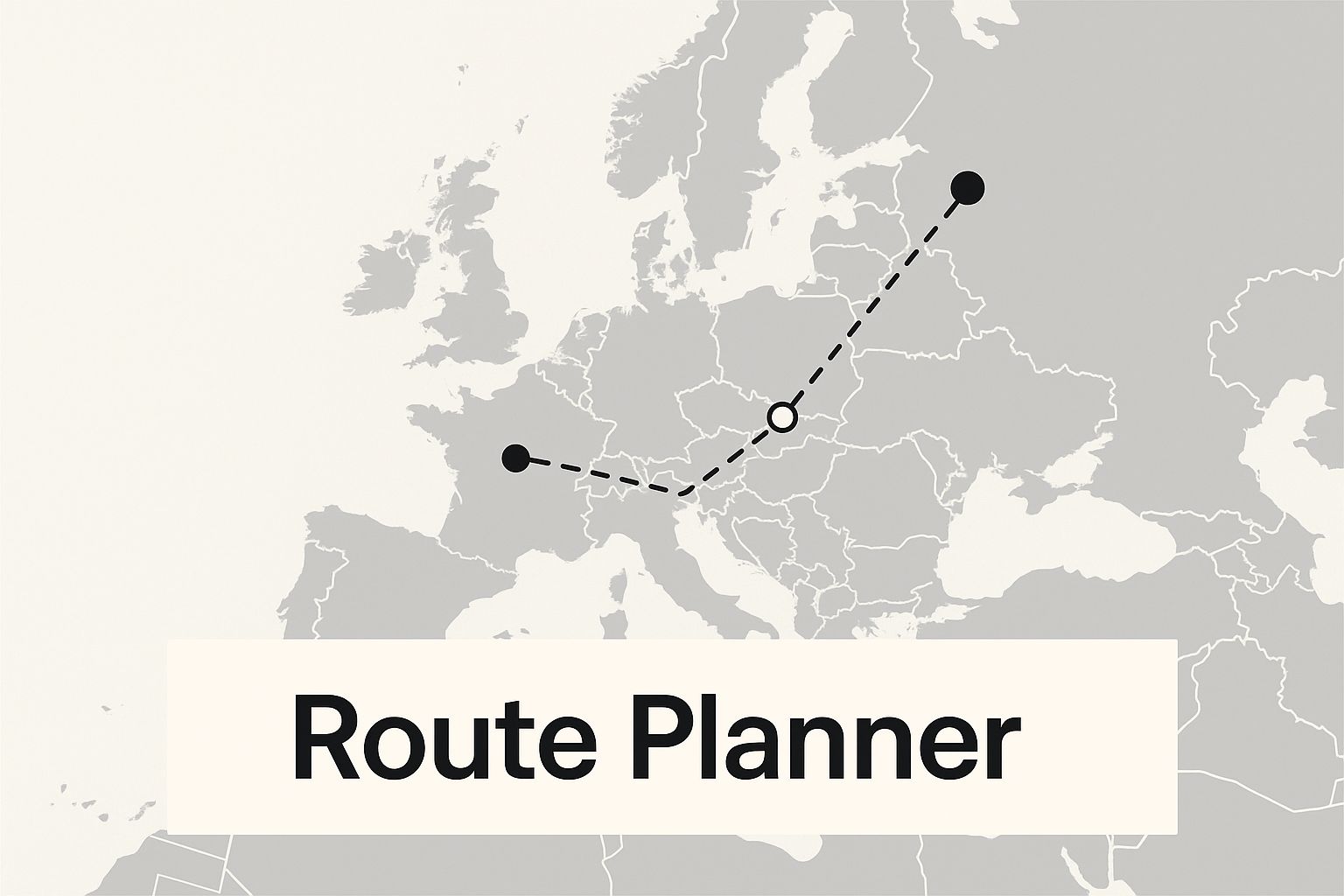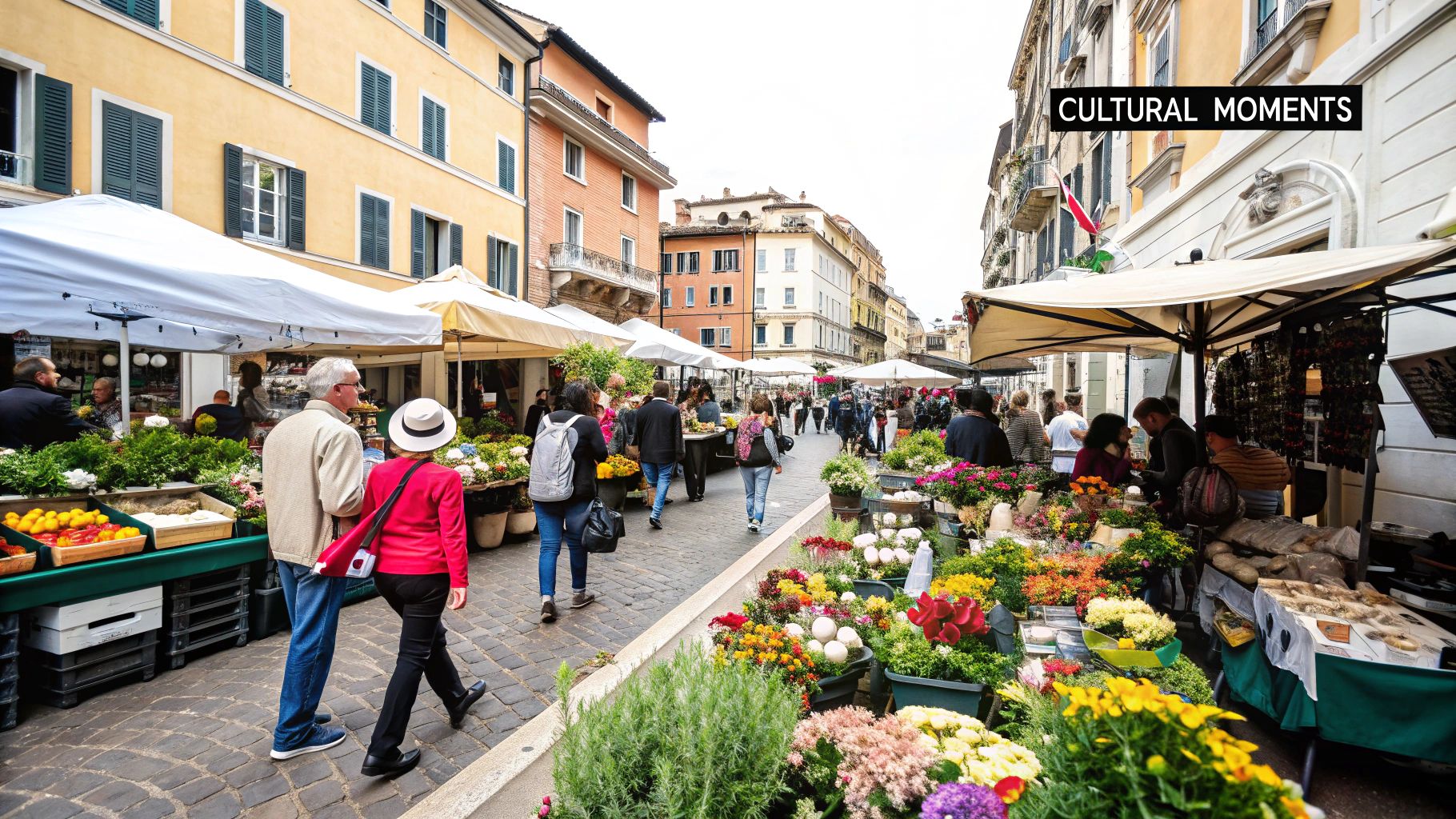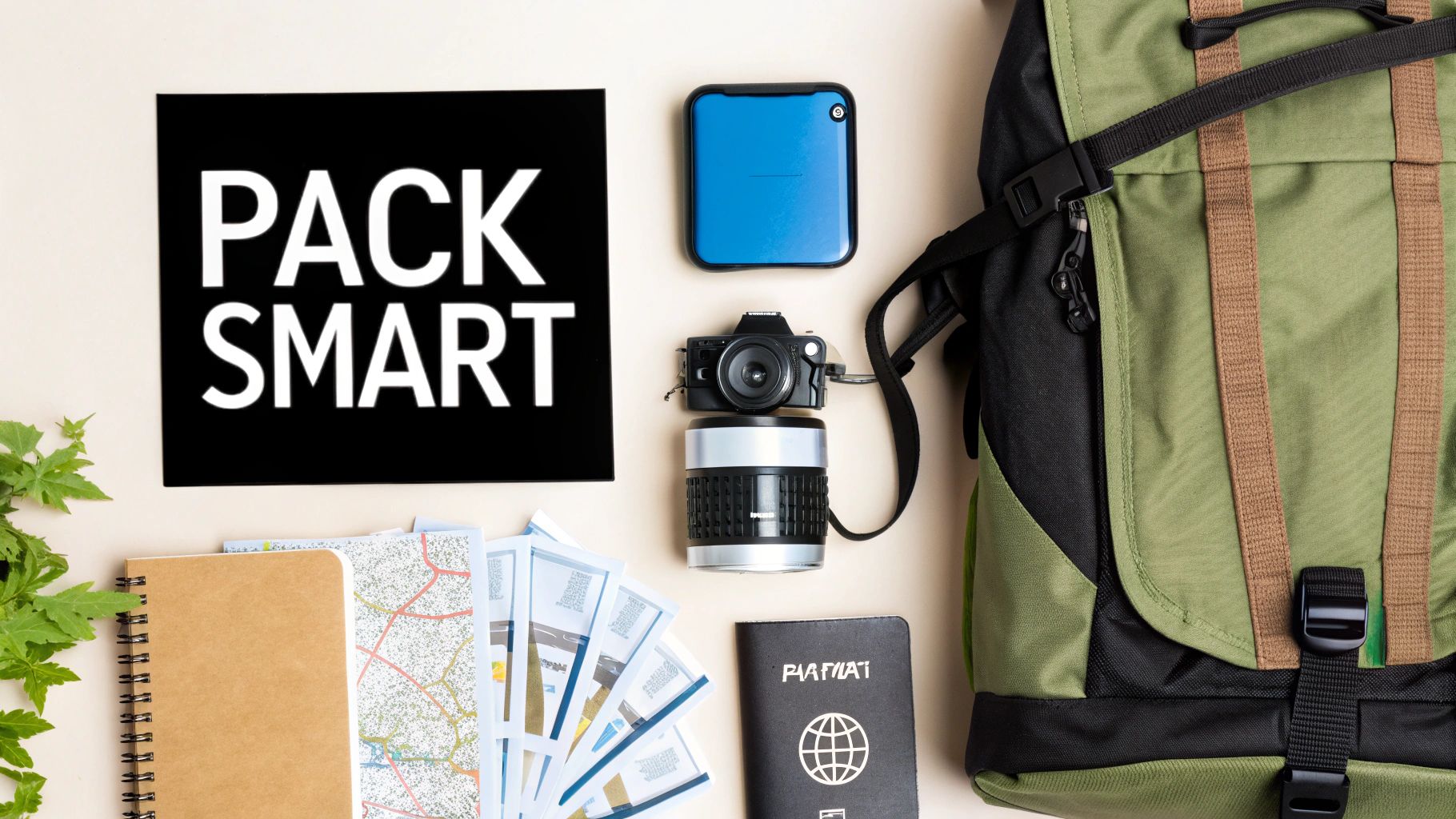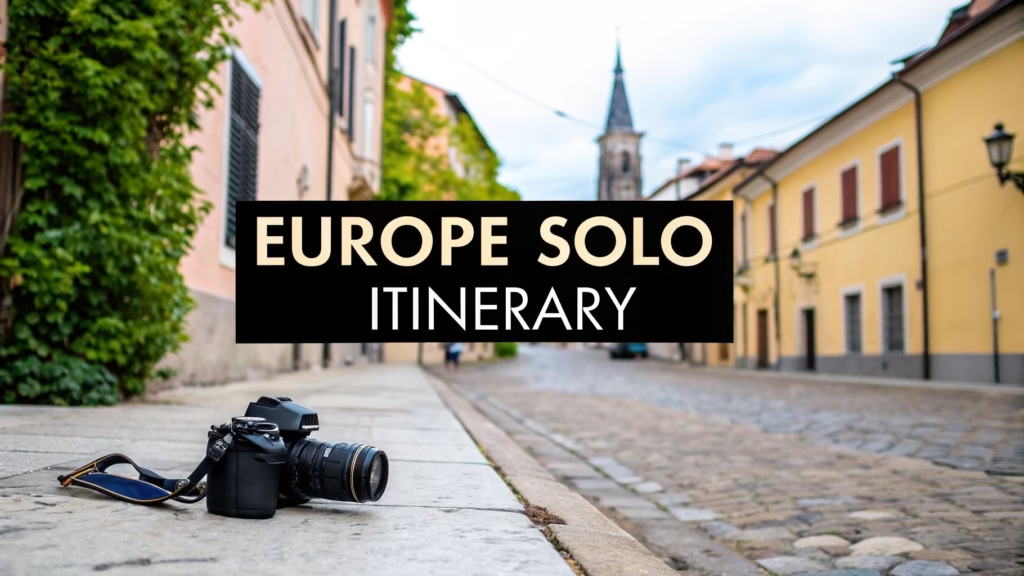Last Updated on
Why Europe Remains the Solo Traveler’s Paradise

Europe continues to beckon solo travelers, offering a captivating blend of history, culture, and adventure. Its appeal comes from a unique mix of elements perfectly suited to the independent explorer. This makes crafting a fulfilling Europe solo travel itinerary a truly rewarding experience.
Safety and Accessibility: Foundations of Solo Exploration
Europe generally provides a high level of safety, particularly for women, which encourages solo exploration. Combined with this is the continent’s impressive accessibility. Comprehensive public transport networks, ranging from high-speed trains to efficient local buses, link vibrant cities with quaint villages. This allows for a sense of freedom and spontaneity.
For example, a solo traveler can easily board a train in Amsterdam and be exploring the canals of Bruges within hours. This interconnectedness makes independent travel not only practical but genuinely thrilling. This ease of travel is a key factor when planning a Europe solo travel itinerary.
Europe is a top choice for solo travelers, especially women. Approximately 54% of solo female travelers recommend Europe as an ideal first solo trip destination, primarily due to its safety, culture, and accessibility. This trend aligns with the overall growth in solo travel. In 2024, there was a notable rise in solo travelers, with 24% of Brits planning solo trips in 2025. Europe’s diverse offerings, from historical landmarks to modern cities like Barcelona, Rome, and Paris, make it a perfect destination for those wanting a mix of culture and adventure. Find more detailed statistics here: https://photoaid.com/blog/solo-travel-statistics/
Cultural Immersion and Openness: Embracing the Solo Spirit
Europe’s rich tapestry of cultures creates an atmosphere of openness and acceptance for solo travelers. Locals often welcome visitors with genuine warmth. This makes it easy to connect with people, learn about local customs, and immerse oneself in the destination’s distinct character. The widespread use of English across the continent simplifies communication and makes forming meaningful connections easier. You might be interested in: Our sitemap.
Diverse Experiences: Tailoring Your Solo Adventure
From the sun-drenched Mediterranean beaches to the majestic Alps, Europe’s diversity provides something for every solo traveler. Whether your passion is historical exploration, artistic inspiration, or exhilarating adventures, the continent delivers. This means a personalized Europe solo travel itinerary truly becomes a journey of self-discovery.
The following data chart visually represents the popularity of different activities among solo travelers in Europe, based on recent survey data.
Solo Traveler Activity Preferences in Europe
| Activity | Percentage |
|---|---|
| Exploring Historical Sites | 45% |
| Visiting Museums & Galleries | 38% |
| Trying Local Cuisine | 52% |
| Hiking & Outdoor Activities | 30% |
| Attending Local Events | 25% |
| Relaxing at Cafés/Parks | 40% |
This bar chart reveals that trying local cuisine and exploring historical sites are the top activities for solo travelers in Europe. While outdoor activities and attending local events remain popular, they are slightly less favored compared to more culturally immersive experiences.
To help solo travelers better plan their trips, here’s a table comparing some top European cities:
Top European Cities for Solo Travelers
A comparison of popular European destinations based on factors important to solo travelers
| City | Safety Rating | Cost Level | Public Transport | Solo-Friendly Activities |
|---|---|---|---|---|
| Amsterdam | High | Medium-High | Excellent | Canal tours, museums, cycling |
| Barcelona | Medium | Medium | Excellent | Architecture, beaches, tapas tours |
| Rome | Medium | Medium | Good | Historical sites, cooking classes, art |
| Paris | Medium | High | Excellent | Museums, walking tours, cafes |
| Berlin | High | Medium | Excellent | History, nightlife, street art |
This table offers a quick glance at factors like safety, cost, transportation, and activities, allowing solo travelers to make more informed decisions about where to go. For example, Amsterdam and Berlin score high on safety, while Paris leans towards a higher cost of living. Each city boasts unique activities, catering to different interests.
Crafting Your Dream Europe Solo Travel Itinerary
Turning your European dream into a solo travel itinerary requires a delicate balance. You need the structure of a well-thought-out plan combined with the flexibility to embrace spontaneous adventures. It’s about creating a framework that truly reflects your personal travel style, whether that involves slow travel in a few cherished locations or a whirlwind tour across multiple countries.
Defining Your Travel Rhythm and Destination Selection
First, think about your ideal pace. Do you picture yourself lingering in charming Parisian cafes for days, soaking up the city’s artistic energy? Or are you drawn to a more fast-paced adventure, checking off iconic landmarks across several countries? This initial self-reflection will inform your destination choices and the overall structure of your Europe solo travel itinerary.
Next, select destinations that complement each other geographically and culturally. This helps minimize travel time and maximize your exposure to diverse experiences. For example, a Central European adventure might take you from Prague to Vienna and then on to Budapest. Each city offers a unique cultural flavor while being easily accessible by train. You might be interested in: How to Master Itinerary Planning.
Building Flexibility and Embracing the Unexpected
While pre-trip planning is essential, incorporating flexibility into your Europe solo travel itinerary is equally vital. Unexpected detours and chance encounters often become the most treasured travel memories. Be sure to include buffer days for spontaneous explorations. Perhaps you’ll discover a hidden gem or simply want to relax and savor the atmosphere of a place that unexpectedly resonates with you.
This adaptability also allows you to adjust to the unexpected. Travel delays or intriguing local events might shift your plans, and building in flexibility lets you embrace these opportunities. Think of your itinerary as a guideline, not a rigid schedule, leaving room for serendipitous discoveries.
Leveraging Technology and Community Wisdom
A wealth of resources exists to simplify the logistics of planning a Europe solo travel itinerary. Route-planning apps can optimize travel times and suggest transportation alternatives. Online communities of solo travelers offer invaluable insights, sharing firsthand experiences about everything from train connections to seasonal tips and off-the-beaten-path treasures.
Furthermore, consider the changing demographics of solo travel in Europe when planning. While women remain a significant portion of solo travelers, men are increasingly embracing independent adventures. According to Booking.com, 63% of men are looking to travel solo compared to 54% of women. This shift reflects broader societal changes and the rise of digital nomads, many of whom are attracted to Europe’s excellent infrastructure and connectivity.
You can explore this topic further here: Solo Travel Statistics. If you’re considering extending your solo journey beyond Europe, Buenos Aires offers a vibrant cultural scene. Check out these tips for traveling solo to Buenos Aires. By combining these resources with your own research, you can create a truly personalized and enriching European solo travel adventure.
Finding Your Perfect Home Base Across Europe
The right accommodation can make or break a solo trip. When exploring a new place independently, your lodging becomes even more crucial. Let’s explore the diverse world of European accommodation options for solo adventurers.
From Hostels to Hotels: A Spectrum of Solo-Friendly Options
Europe boasts a wide range of accommodation choices, from lively hostels ideal for meeting fellow travelers to charming boutique hotels offering tranquil escapes after a day of sightseeing. The perfect fit hinges on your budget, travel style, and desired level of social interaction.
For budget-conscious travelers seeking social connection, hostels are a fantastic option. Hotels, on the other hand, provide more privacy and comfort. The key is selecting properties that genuinely cater to solo travelers.
Look for places with communal spaces if you’re eager to socialize, or prioritize those with single rooms without hefty single supplements if you prefer more solitude. Consider factors like location, amenities, and reviews from other solo travelers. You might be interested in: How to master Location Sitemap
Strategic Booking and Avoiding the Single Supplement
One of the biggest hurdles for solo travelers is the dreaded single supplement – the extra fee for occupying a room designed for two. However, many European accommodations now cater to solo travelers by offering single rooms without this surcharge or waiving it during certain times. Use online booking platforms like Hotelscan that allow you to filter for “single occupancy” or “no single supplement” to find the best deals.
Another smart strategy is considering alternative options like guesthouses, bed and breakfasts, or even home-sharing platforms like Airbnb. These often offer more affordable single rooms and a chance to connect with locals and experience the culture more authentically.
The Rise of Solo-Friendly Travel and Accommodations
A crucial aspect of solo travel in Europe is the increasing trend of solo-friendly accommodations and tour services. Companies like Riviera Travel have noted an 18% increase in solo travelers, many opting for tours to explore destinations they might feel less confident visiting independently. This rise is fueled by the industry’s response to solo travelers’ needs, such as offering no single supplements on accommodations.
The ease of booking and organizing trips through online platforms has made solo travel even more accessible, contributing to a 170% increase in searches for solo rooms on platforms like Hotelscan.com. Find more detailed statistics here: https://www.condorferries.co.uk/solo-travel-statistics
Emerging Trends: Co-living and Solo-Focused Programming
The accommodation landscape for solo travelers is constantly evolving. The rise of co-living spaces provides a unique blend of private living and shared communal areas, creating a sense of community while maintaining personal space. Many hostels are also adapting to the needs of mature solo travelers, offering dedicated programs, events, and even private rooms within a social environment.
These trends reflect a growing awareness of the diverse needs of solo travelers. By researching your options, you can find the perfect European home base that complements your Europe solo travel itinerary and enhances your travel experience. This creates a comfortable and enriching foundation for your solo adventures, whether you seek lively social interaction or peaceful tranquility.
Legendary European Routes That Solo Travelers Swear By
Picking the perfect route for your Europe solo travel itinerary is a big decision. It can make or break your trip. Some routes are especially popular with solo adventurers, offering a great mix of cultural experiences, easy logistics, and solo-friendly options. Let’s explore a few of these well-trodden paths.
The Mediterranean Coast-Hopping Adventure
This route winds through several countries along the Mediterranean Sea. Think beautiful beaches, bustling cities, and ancient ruins. You could start in Barcelona, taking in the architectural wonders of Gaudi. Then, head south along the Spanish coast to Valencia. From there, hop over to Italy, maybe stopping in Rome and Naples. Finally, continue on to the Greek islands. Each stop offers unique cultural experiences, from savoring the local cuisine to exploring historical sites.
This itinerary is perfect for solo travelers. It provides a basic structure while still allowing for flexibility. Ferries and trains connect most destinations, making it easy to change your plans on the fly. Plus, there are tons of hostels and solo-friendly accommodations, so meeting other travelers is a cinch.
The Eastern European Heritage Trail
Looking for a more budget-friendly option? Consider exploring Eastern Europe. This route often begins in Prague, with its charming Old Town Square and magnificent castle. Next, travel to Krakow, Poland, to explore its historic Jewish quarter and moving reminders of World War II. Budapest, Hungary, with its thermal baths and buzzing nightlife, is another must-see on this itinerary.
Eastern Europe offers authentic experiences at a fraction of the cost of Western Europe. It’s a chance to discover a region rich in history and culture, often missed by typical tourist routes. Affordable and readily available public transportation also makes solo travel in this region super easy.
The Scandinavian Nature Escape
If nature is your thing, a Scandinavian itinerary might be just right for your Europe solo travel itinerary. This journey takes you through the stunning landscapes of Norway, Sweden, and Denmark. From hiking in Norway’s fjords to exploring the vibrant cities of Stockholm and Copenhagen, this trip balances natural beauty with urban exploration.
This region can be pricier. However, the experience of seeing the Northern Lights or hiking through untouched forests is truly special. The efficient public transport system and plentiful hostels and campsites make solo navigation simple. Learn more in our article about how to master European Travel.
Adapting These Routes to Your Interests
These routes are simply starting points. Feel free to customize them to fit your passions. Foodie? Focus on culinary experiences, maybe taking a cooking class in Italy or exploring local markets in Budapest. History buff? Spend more time exploring ancient ruins or visiting museums. Love the outdoors? Incorporate more hiking, cycling, or kayaking.
To help you visualize some possible trips, here’s a table comparing different 2-week itineraries:
Sample 2-Week European Itineraries: Comparison of different route options with key information for solo travelers
| Itinerary Name | Countries Covered | Travel Style | Budget Range | Ideal Season | Highlights |
|---|---|---|---|---|---|
| Mediterranean Coast-Hopping | Spain, Italy, Greece | Relaxed | Medium-High | Summer | Beaches, ancient ruins, vibrant cities |
| Eastern European Heritage Trail | Czech Republic, Poland, Hungary | Cultural | Budget-Friendly | Spring/Fall | Historical sites, charming towns, nightlife |
| Scandinavian Nature Escape | Norway, Sweden, Denmark | Adventure | Medium-High | Summer/Winter | Fjords, hiking, Northern Lights, city life |
| Western European Capitals | France, UK, Netherlands | Fast-Paced | Medium-High | Spring/Fall | Iconic landmarks, museums, art |
| Balkan Peninsula Exploration | Croatia, Montenegro, Serbia | Adventure | Budget-Friendly | Spring/Summer | Coastline, mountains, historical sites |
As you can see, there are options for every travel style and budget.
The best part of solo travel? Freedom! Embrace the flexibility to change your plans and discover the unexpected joys waiting for you.
Mastering Your Solo European Adventure Budget
A well-planned budget is essential for a successful Europe solo travel itinerary. It helps you maximize your trip without overspending or missing out on enriching experiences. By understanding the financial nuances of solo travel, you can make your money go further and create a truly memorable journey.
Smart Accommodation Strategies for Solo Travelers
Accommodation costs can significantly impact your budget, especially when traveling alone. However, there are clever ways to minimize these costs without sacrificing comfort. One key strategy is seeking out accommodations that waive the single supplement. Many hotels and hostels now offer single rooms without this surcharge, making solo travel more affordable.
Another great approach is considering alternative accommodation options. Guesthouses, bed and breakfasts, and home-sharing platforms like Airbnb offer comfortable and cost-effective choices. Hostels are also a budget-friendly option and a fantastic way to connect with fellow travelers, sharing not only accommodation expenses but also experiences and travel tips.
Dining Like a Local: Saving Money and Experiencing Culture
Food is a vital part of exploring Europe, but eating out for every meal can quickly deplete your funds. To save money, pack picnics to enjoy in picturesque parks or prepare some of your own meals, particularly if your accommodation has a kitchen. Exploring local markets and grocery stores lets you discover fresh, regional produce and ingredients.
Embrace local eateries and street food stalls for authentic and affordable culinary experiences. These options give you a real taste of the local culture and are often much more budget-friendly than tourist-focused restaurants. You might be interested in: Mastering Your Europe Budget
Region-Specific Budget Insights: Balancing Cost and Experience
Europe offers a wide spectrum of price points. Scandinavian countries and major Western European capitals tend to be more expensive, while Eastern European destinations are generally more budget-friendly. Strategically combining higher-cost destinations with more affordable locations can help you balance your spending.
For instance, if you dream of visiting Paris but want to manage your budget, consider spending a few days in a more affordable city like Prague or Budapest beforehand. This allows you to experience both iconic destinations and hidden gems without overspending.
Travel Style and Budget: From Backpacker to Boutique
Your travel style significantly influences your budget. Backpacking offers maximum budget control, while a mid-range approach provides more comfort and flexibility. Luxury travel provides a different level of experience but comes at a higher price.
Consider your priorities. Are you comfortable staying in hostels and using public transportation, or do you prefer more comfortable hotels and private transfers? Aligning your travel style with your budget will lead to a more enjoyable and financially sustainable trip.
Digital Tools for Budget Management
Managing your finances while traveling is simpler than ever with travel budgeting apps. These tools allow you to track your spending, convert currencies, and find deals on flights and accommodation. Staying financially organized helps you stay within budget and avoid costly errors.
By implementing these strategies, you can craft a Europe solo travel itinerary that is both enriching and affordable, allowing you to focus on creating unforgettable memories and enjoying the freedom of solo exploration.
Staying Safe While Embracing Solo Freedom in Europe

Safety is paramount, especially when venturing out on a solo trip. This section offers practical safety tips for your Europe solo travel itinerary, ensuring a worry-free and enjoyable adventure.
Pre-Departure Preparations: Setting the Stage for Safe Travels
Before you pack, taking a few key steps can significantly improve your safety. Thorough research on your destinations is crucial. Familiarize yourself with local customs, laws, and any specific safety concerns for each area you plan to visit. Let someone back home know your itinerary and maintain regular check-ins.
Creating digital and physical copies of essential documents, such as your passport and visa, is another vital step. Store these copies separately from the originals. This precaution ensures access to crucial information, even if your belongings are lost or stolen.
Everyday Safety Practices: Navigating New Environments
Once you arrive, simple daily practices can significantly impact your safety. Projecting confidence as you explore new cities can deter unwanted attention. Be aware of your surroundings without becoming overly anxious. For instance, avoid walking alone late at night in dimly lit areas.
If you must walk alone at night, walk with purpose and stay aware of your surroundings. Be mindful of your belongings, particularly in crowded tourist areas known for pickpocketing. Keep valuables secure and consider using a money belt or hidden pouch. Learning basic phrases in the local language can also be helpful in emergencies and demonstrates respect for the local culture.
Technology as Your Travel Companion: Safety Apps and Connectivity
Technology can be invaluable for solo travelers. Numerous safety apps like Noonlight offer features such as location sharing, emergency alerts, and even local safety information. Staying connected is also essential. Invest in a local SIM card or portable Wi-Fi hotspot to ensure reliable communication throughout your trip.
Consider using a digital “breadcrumb” system to track your daily movements, sharing this information with a trusted contact back home. This allows someone to know your general location should you require assistance.
Specific Considerations for Different Travelers: Tailored Safety Advice
Different demographics may have unique safety concerns. Female travelers might research women-only accommodations or tours. LGBTQ+ travelers should be aware of local laws and attitudes toward the LGBTQ+ community in their chosen destinations. Mature travelers might consider travel insurance that covers pre-existing medical conditions.
Some cities have designated “women-friendly” taxis or transportation services. Knowing about these resources beforehand can provide added peace of mind. Connecting with online communities of solo travelers can offer valuable insights and support. Sharing experiences and tips within these groups can further enhance safety and foster a sense of community while traveling independently.
By taking these precautions and adapting them to your individual needs, you can cultivate a safe and empowering experience, enjoying the freedom and flexibility of your Europe solo travel itinerary. Remember, preparation and awareness are your best allies in navigating new environments with confidence.
Creating Genuine Connections on Your Solo Journey

Solo travel offers a unique opportunity for self-discovery. But it doesn’t have to mean total isolation. In fact, a surprising joy of exploring Europe alone is the chance to connect with people from all walks of life. This section of your Europe solo travel itinerary guide helps you balance solitude with the enriching experience of human interaction.
Social Entry Points: Starting Conversations and Building Bonds
Europe offers a wealth of social opportunities, even when traveling alone. Walking tours, for example, provide a natural setting for conversation. Sharing a common experience, like admiring a landmark or exploring hidden alleys, makes it easy to chat with fellow participants. It’s a simple way to connect with others who share your interest in exploration.
Language exchange meetups are another great way to engage with locals. These gatherings let you practice your language skills while learning about the culture firsthand. Many cities also have social groups or clubs catering to various interests, from hiking and photography to book clubs. Joining one of these can instantly connect you with like-minded people.
Honoring Your Social Rhythm: Balancing Connection and Solitude
Your desire for social interaction will fluctuate throughout your trip. Some days you might crave lively conversation, while others you might prefer quiet reflection. Honoring this social rhythm is crucial for a successful solo journey.
When you’re feeling social, don’t hesitate to start conversations. A simple “hello” or a question can open doors to engaging interactions. But respecting your need for solitude is equally important. Don’t feel pressured to participate in group activities or engage in constant conversation if you need to recharge.
Navigating Cultural Differences: Understanding Social Norms
Social norms vary across European countries. In some cultures, it’s perfectly acceptable to chat with strangers in public, while in others, it’s less common. Researching cultural etiquette beforehand can help you navigate these differences with sensitivity.
Understanding these nuances enhances your interactions and prevents misunderstandings. For instance, direct eye contact can be a sign of respect in some cultures, while in others it might be perceived as confrontational. Being mindful of these differences allows you to connect with locals respectfully.
Reframing Loneliness: Embracing Solo Moments
It’s normal to experience moments of loneliness, even on exciting solo adventures. Try to reframe these moments as opportunities for deeper cultural immersion and self-reflection. Use this time to explore at your own pace, savor a meal without distractions, or journal your thoughts.
Remember, solo travel is a chance to connect with yourself just as much as it is to connect with others. Embrace the freedom to discover new passions and enjoy your own company. When you genuinely crave connection, reach out to fellow travelers, join a local activity, or strike up a conversation. Your Europe solo travel itinerary is about finding the perfect balance between solitude and connection, creating a truly enriching experience.

Hi, I’m Lily, a travel writer based in the UK who loves exploring everything from familiar hometown gems to the varied landscapes across Europe. Whether I’m strolling through charming coastal villages or hopping trains across the continent, I’m always on the lookout for authentic, unexpected stories and experiences.
My writing style is simple and relatable—think no-fuss guides to finding the best pasty in Cornwall or stress-free tips for getting around European cities. If there’s a great view, tasty food, or a bit of history involved, chances are I’m already scribbling notes about it.

